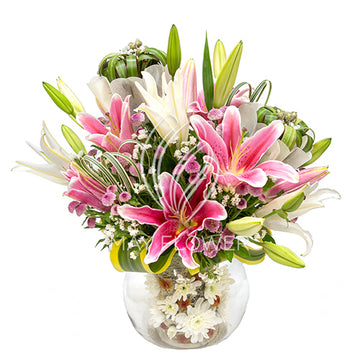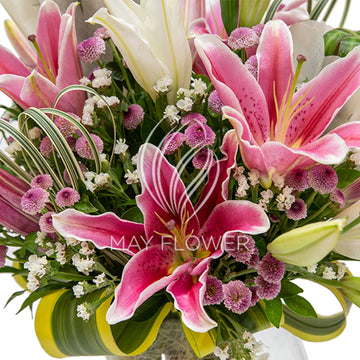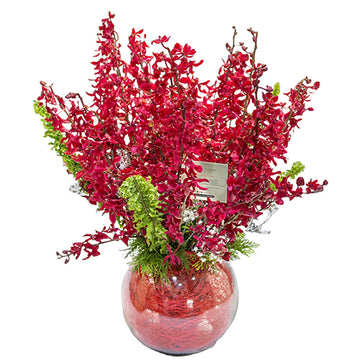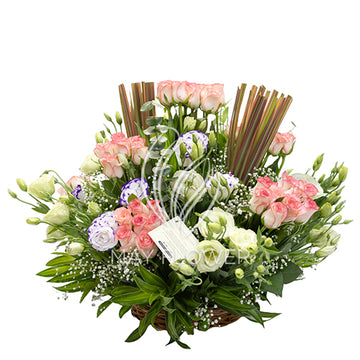Poinsettia
The poinsettia is a culturally and commercially important plant species of the diverse spurge family that is indigenous to Mexico and Central America. It is particularly well known for its red and green foliage and is widely used in Christmas floral displays. It derives its common English name from Joel Roberts Poinsetta the first United States Minister to Mexico,who introduced the plant into the United States in 1825.
Poinsettia are small shrubs typically at a height of about 2ft. The plant bears dark green leaves that are less than 20cms in length. The green leaves change colors through photoperiodism, they require total darkness from 12 hours to a minimum of 5-6 days in a row to change their color. They also require abundant light during the day to get the brightest color form.
The flowers of the poinsettia are unassuming and do not attract pollinators. They are grouped within small yellow structures found in the center of each leaf bunch, and are called cyathia.
The poinsettia are native to Mexico. They are found in the wild in tropical forests and medium elevations in this region. There are over 100 varieties of poinsettias.
Poinsettias are commonly grown as an indoor plant where it prefers good morning sun, then shade in the hotter part of the day. Contrary to popular belief, flowering poinsettia can be kept outside, even during winter, as long as it is kept frost-free.
Selecting Your Poinsettia
The plant you choose should have dark green foliage. Fallen,low or damaged leaves indicate poor handling or fertilization, lack of water or a root disease problem. The colorful flower bracts (red, pink, white or bicolor pink and white) should be in proportion to the plant and pot size. Little or no pollen should be showing oil the actual flowers (those red or green button-like parts in the center of the colorful bracts).
Christmas Care
Be sure the plant is well wrapped when you take it outside on your trip home because exposure to low temperatures for even a short time can injure leaves and bracts. Unwrap the plant as soon as possible because the petioles (stems of the leaves and bracts) can droop and twist if the plant is left wrapped for too long.
For maximum plant life, place your poinsettia near a sunny window or some other well-lighted areas. Do not let any part of the plant touch cold window panes. Poinsettias are tropical plants and are usually grown at temperatures between 60 and 70 degrees F in greenhouses, so this temperature range will at home is best for a longer plant life. High temperatures will shorten the life of the bracts. Poinsettias do not tolerate warm or cold drafts so keep them away from radiators, air conditioners, and fans as well as open windows or doors. Place your poinsettia in a cooler room at night (55 to 60 degrees F is ideal) to extend the blooming time.
Examine the soil daily and water only when it feels dry. Always water enough to soak the soil to the bottom of the pot and discard the excess water. If you don’t water enough, the plant will wilt and the lower leaves will droop and eventually fall off. If you water too much the lower leaves will turn yellow and then drop. If you keep your plant for several months, apply a soluble houseplant fertilizer, once or twice a month according to the manufacturer’s recommendations.
Trying to keep the plant from year to year is usually disappointing as it is difficult to provide optimum growing conditions. However, you can give it a try, as follows:
In March, gradually reduce watering. Prune hard back once the plant drops its leaves and keep fairly dry.
In early May, increase watering. Re-pot when new shoots start to develop.
Once established, feed weekly with a balanced liquid fertiliser.
As the days shorten, from October 10 to 20, allow the plants to have 12 hours of light each day. For the remaining 12 hours, they need to be kept in darkness at a minimum temperature of 65F (18C). Artificial light is acceptable to supplement daylight.
With this treatment, the red bracts and tiny yellow flowers should be brightening up the winter gloom from December.
Interesting history on Poinsettias
Poinsettia plants are native to Central America, especially an area of southernMexico known as ‘Taxco del Alarcon’ where they flower during the winter. The ancient Aztecs called them ‘cuetlaxochitl’. The Aztecs had many uses for them including using the flowers (actually special types of leaves known as bracts rather than being flowers) to make a purple dye for clothes and cosmetics and the milky white sap was made into a medicine to treat fevers. (Today we call the sap latex!)
The poinsettia was made widely known because of a man called Joel Roberts Poinsett (that’s why we call them Poinsettia!). He was the first Ambassador from the USA to Mexico in 1825. Poinsett had some greenhouses on his plantations in South Carolina, and while visiting the Taco area in 1828, he became very interested in the plants. He immediately sent some of the plants back to South Carolina, where he began growing the plants and sending them to friends and botanical gardens.
One of the friends he sent plants to was John Barroom of Philadelphia, who gave the plant to his friend, Robert Buist, a plants-man from Pennsylvania. Robert Buist was probably the first person to have sold the poinsettias under their botanical, or latin name, name ‘Euphorbia pulcherrima’ (it means, ‘the most beautiful Euphorbia’). It is thought that they became known as Poinsettia in the mid 1830’s when people found out who had first brought them to America from Mexico.
There is an old Mexican legend about how Poinsettias and Christmas come together, it goes like this:
There was once a poor Mexican girl called Pepita who had no present to give the the baby Jesus at the Christmas Eve Services. As Pepita walked to the chapel, sadly, her cousin Pedro tried to cheer her up.
‘Pepita’, he said “I’m sure that even the smallest gift, given by someone who loves him will make Jesus Happy.”
Pepita didn’t know what she could give, so she picked a small handful of weeds from the roadside and made them into a a small bouquet. She felt embarrassed because she could only give this small present to Jesus. As she walked through the chapel to the altar, she remembered what Pedro had said. She began to feel better, knelt down and put the bouquet at the bottom of the nativity scene. Suddenly, the bouquet of weeds burst into bright red flowers, and everyone who saw them were sure they had seen a miracle. From that day on, the bright red flowers were known as the ‘Flores de Noche Buena’, or ‘Flowers of the Holy Night’.
The shape of the poinsettia flower and leaves are sometimes thought as a symbol of the Star of Bethlehem which led the Wise Men to Jesus. The red colored leaves symbolize the blood of Christ. The white leaves represent his purity.
The Poinsettia is also the national emblem of Madagascar.


























